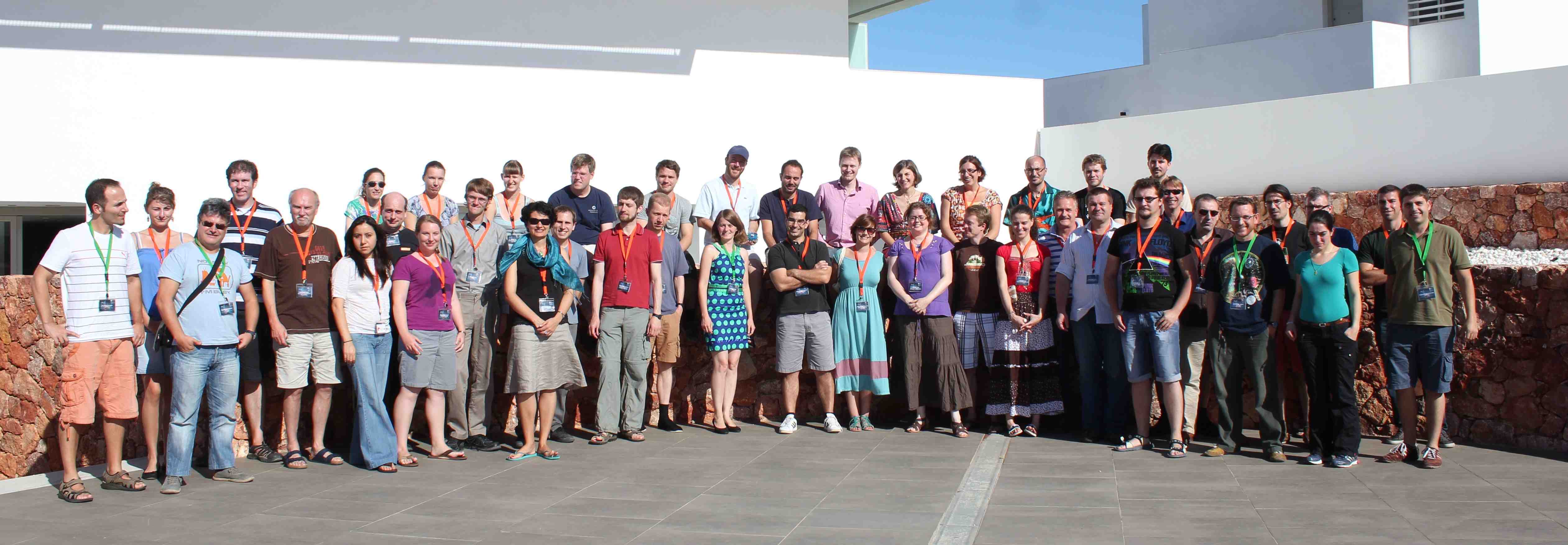When you click on the presentations, be aware that some presentations are large files!
| Participant |
Institute |
Contribution |
| Ricardo Amorín |
IAA / OAR, Rome |
Extreme emission line galaxies in the local universe and beyond: potential hosts of GRBs |
| Antonio Cabrera-Lavers |
Grantecan |
GRBs at GTC |
| Lise Christensen |
DARK, Copenhagen |
Properties of strong gravitationally lensed galaxies |
| Paul Crowther |
Univ. of Sheffield |
Massive stars, SNe and their star-forming regions |
| Antonino Cucchiara |
GSFC |
Gemini Spectroscopy of the short burst GRB 130603B afterglow and host |
| Antonio de Ugarte Postigo (co-chair) |
IAA-CSIC/DARK, Granada |
Introduction to Cabo de Gata |
| Jonathan Elliott |
MPE, Garching |
The solar-metallicity host of GRB 110918A |
| Mette Friis |
Univ. of Iceland |
Thermal emission in the early X-ray afterglows of GRBs |
| Chris Fryer |
LANL |
Progenitors of SNe and GRBs |
| Christa Gall |
NASA/DARK/Univ. of Aarhus |
Formation and evolution of dust in galaxies |
| Rubén García-Benito |
IAA-CSIC |
The radial structure of M/L in CALIFA |
| Miriam García |
Centro de Astrobiologia-CSIC |
Massive stars in metal-poor environments: One step forward from the SMC |
| Diego Götz |
CEA Saclay - DSM/Irfu/SAp |
Catching the first stars with SVOM |
| Javier Gorosabel |
IAA-CISC/UPV-EHU |
GTC observations of GRB afterglows and their hosts |
| John Graham |
STScI / MPE |
The metal aversion of long GRBs |
| José Groh |
Geneva Observatory |
The surprising look of SN and GRB progeni-tors from stellar evolution models |
| Olga Hartoog |
Univ. of Amsterdam |
A double DLA towards a GRB at z=5 |
| Carolina Kehrig |
IAA-CSIC |
IFU spectroscopy of metal-poor WR HII galaxies |
| Patrick Kelly |
UC Berkeley |
Host environments of nearby CC-SNe + LGRBs |
| Ia Kochiashvili |
DARK, Copenhagen |
Interlopers for the z~7 galaxies and their nature |
| Matthew Lehnert |
Inst. d'Astrophysique de Paris |
SF in distant galaxies: setting the stage for the parent popu-lation of GRB hosts |
| Giorgos Leloudas |
OKC, Stockholm |
SLSNe and their hosts |
| Laura Lopez |
MIT, Boston |
What would the remnant of a GRB look like? |
| Ragnhild Lunnan |
Harvard Univ. |
The extreme environments of SLSNe - connections to long GRBs? |
| Daniele Malesani |
DARK, Copenhagen |
Probing star-forming galaxies at all redshifts via long-duration GRB hosts |
| Michal Michalowski |
Univ. of Edinburgh |
Sub-mm and radio observations of SF galaxies |
| Bo Milvang-Jensen |
DARK, Copenhagen |
Ly-alpha emission from GRB hosts based on the TOUGH survey |
| Pavel Minaev |
IKI, Moscow |
To the dichotomy of short gamma-ray bursts |
| Daniel Miralles Caballero |
UAM |
Ionizing stellar population in NGC 3310 |
| Maryam Modjaz |
NYU |
Stellar Forensics with environments of stripped envelope core-collapse supernovae |
| Mercedes Mollá |
CIEMAT |
Chemical evolution models for spiral and irregular galaxies |
| Gabriela Montes |
UC Santa Cruz |
Understanding the X-ray emission of close massive binaries: The case WR 20A |
| Ignacio Negueruela |
Univ. of Alicante |
How should the progenitors of IIp-SNe look like? |
| Manfred Pakull |
Obs. de Strasbourg |
He+ ionizing radiation in low metallicity starbursts |
| Polychronis Papaderos |
Univ. do Porto |
Extremely metal poor galaxies |
| Enrique Pérez-Montero |
IAA-CSIC, Granada |
WR galaxies and the interplay between gas and stars in star-forming systems |
| Daniel Perley |
Caltech/Hubble Fellow |
Promises and Perils for Constraining the Cosmic Star-Formation History with GRBs |
| Alexei Pozanenko |
IKI, Moscow |
Testing a two-jet model of short GRBs |
| Martin Roth |
AIP |
3D spectroscopy of massive stars, SNe, and other point sources in crowded fields |
| Maria del Mar Rubio Díez |
CAB-CSIC |
VFTS 682: an isolated twin of R136's WN5h core stars |
| Sebastián Sánchez |
IAA-CSIC/CAHA, Almería |
1) The CALIFA survey: Exploring the evolution of galaxies with HII regions
2) Summary talk |
| Steve Schulze |
Pont. Univ. Católica, Santiago |
120422A and its connection to high and low-luminosity GRBs |
| Jonatan Selsing |
DARK, Copenhagen |
IFS of Ic-BL SNe |
| Craig Swenson |
Penn State Univ. |
UV/optical and X-ray flares in GRB lightcurves |
| Dorottya Szecsi |
Argelander Inst., Bonn |
Evolution of massive stars in blue compact dwarf galaxies: model tracks, WR stars and final fates |
| Christina Thöne (chair) |
IAA-CSIC, Granada |
1) Scientific introduction
2) Goodbye |
| Susanna Vergani |
CNRS, Paris |
Are LGRBs biased tracers of SFR? Clues from a complete sample of z < 1 LGRB hosts |
| José M. Vílchez |
IAA-CSIC, Granada |
--- |
| Alina Volnova |
IKI, Moscow |
The optical light curve of GRB 130427A & SN evidence |
Darach Watson |
DARK, Copenhagen |
Origin of soft X-ray absorption in GRB afterglows |

